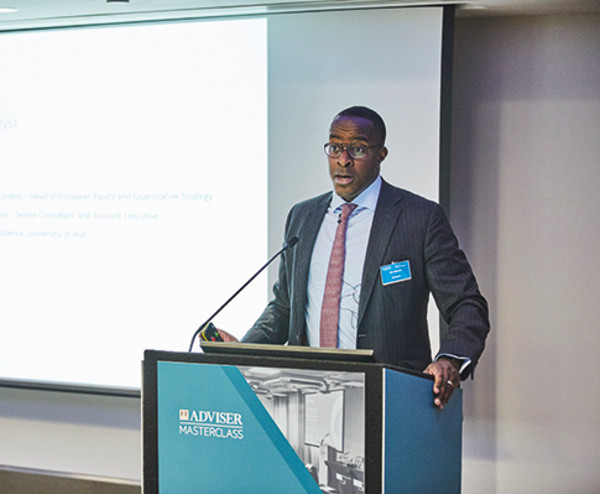

The ever-evolving investment landscape is largely shaped by market conditions, regulation and investor demand.
Advisers must keep up to date with these changes to mitigate risks, maximise returns and meet their client’s objectives.
But how can advisers achieve continued compliance within the changing regulatory landscape, the growing demand for ethical investments, and fluctuating market conditions?
These were some of the topics discussed at the recent FTAdviser Investment Masterclass held on June 4, sponsored by Carmignac and Sarasin, which examined how advisers can ensure they keep clients happy in a new era for investment portfolios.
New era of regulation
Speaking at the event, Mark Spiers, partner at Bovill, pointed out that regulation – specifically Mifid II – has promoted consumer protection by increasing transparency and fiduciary duties such as suitability.
Transparency means giving clients information so they can make informed decisions, while suitability boils down to “more technical client interactions and effective client profiling”, he said.
So understanding the purpose of questions posed to clients, on application forms or as part of suitability assessments, is crucial if advisers are to satisfy their clients.
For this reason, Mr Spiers suggested advisers use free-text boxes and/or meeting notes, as well as using all of the client information.
“We often see gaps in the information on files where basic know-your-client information has not been recorded or has been captured in a format that it is not meaningful,” he said.
Such gaps regularly include generic objectives, where the financial objective is merely income, alongside and ill-defined or conflicting time horizons.
Instead, he suggested objectives be specific and tailored to the individual client and that they clearly outline what the client is looking to achieve with their assets.
“The time horizon should be in line with the client’s financial objective and risk profile and the investment manager should review these in tandem to ensure they are consistent,” he said.
However, when it comes to risk profiling, advisers can get it wrong.
To get it right, Mr Spiers said advisers should use defined risk categories and agreed descriptions, visuals and graphics to illustrate volatility and/or portfolio make-up, and have separate consideration of capacity for loss and knowledge and experience.
Understand your starting point
To find opportunities for investments it helps to recognise cycles and trends and why investors make the decisions they make, noted Obe Ejikeme (pictured), global equity quantitative strategist at Carmignac, also speaking at the event.
“Understanding where your starting point is, is key,” said Mr Ejikeme.
“We are at such a key point in the cycle that if you get it wrong money is going to be lost,” he added.
First, it is important to recognise the long-term outlook, which, in a world where growth remains scarce, does not look great.
Mr Ejikeme said: “In the fixed-income market there is a hunt for yield, but this does not exist in the equity market where there is a hunt for growth.
“What drives equity fundamentals right now is the lack of growth and so people are being forced to chase the highest growing assets.”
Nevertheless, the next 12 to 18 months could look rather more appealing as markets benefit from a recovery, according to Mr Ejikeme.
Investors are facing two distinct time horizons: the long-term and the medium-term cycle.
While growth is scarce in the long term – where a core holding in assets with a proven track record of delivering growth, such as the Nasdaq Stock Market and tech, quality and defensiveness is essential – the mid-term means investors will be faced with a cyclical rebound.
This is where macro-sensitive equities yet to price in recovery, like emerging markets, will profit.
He continued: “Each cycle lasts about three to four years; on average the way up it is going to be 18 to 24 months and another 18 to 24 months on the way down.”
To make the most of the cyclical rebound, investors would do well to choose the equity style suited to each phase of the cycle.
To do this, they must recognise which phase they are in and focus on what comes next.
“If you are already in a recession then that is your least risky thing to worry about, so if you are buying defensive assets now, what you really should be worried about instead is what comes next: recovery.”
But he pointed out that human minds cannot cope with cycles and that “when we are at the bottom we think we are going to be in a recession forever, when we are at the top we think we are going to be in recovery forever”.
But recession, or the capital preservation phases, is not something to be scared of – it is the new norm until growth improves in the long term.
Mr Ejikeme said: “If you live outside of the US, you live in Europe or the emerging markets, you have experienced at least two or three recessions since the global financial crisis.
“We are going to have recessions every three to four years now until we sort out a way out of the growth slump we are in.”
Investing in the decade ahead
Also speaking at the event, Henry Boucher, deputy chief investment officer and fund manager at Sarasin, explained climate change is one of the biggest economic and political challenges of the century, meaning investors will have no choice but to look beyond their carbon footprint to explore the potential impact of stranded assets on investments.
But Mr Boucher pointed out that investing in the growing environmental, social and governance landscape is “not just about reducing exposure to the risks of climate change”, as some investors are re-weighting their portfolios to capitalise on the range of low carbon companies that offer better long-term stability and profitability.
During a panel discussion on how ESG was transforming and informing investment decisions, Mr Boucher explained the real challenge for advisers and clients is not to exclude those companies doing the ‘wrong’ thing, “because unfortunately what you then end up doing is excluding everything”.
Rather, it is about “looking at it holistically” and asking “whether the fund manager is taking into account the long-term risks” and whether they can be engaged with, to speed things along.
Key Points
- Advisers now have to navigate a new era of regulation where transparency and suitabilityis key
- Understanding where you are in the current economic cycle will be crucial to navigating the scarcity of growth
- Investors will be forced to turn away from stranded assets
He said: “I cannot think of any company that does not have some kind of issue; the key thing as an investor is to encourage them to engage with ESG faster.”
Also on the panel, Emma Hunt, head of responsible investment at St James’s Place, said core ESG integration into all funds investors invest in is one of the company’s main goals.
She added that advisers consider the role of the next generation as leaders in sustainable investing.
She suggested that an information exchange is encouraging more conversations between generations.
“Something is happening and it is not just being driven by an intergenerational transfer of wealth… it’s happening at family gatherings and Sunday lunches.”
How advisers manage these shifts is going to be key to their success in the decades ahead.
Victoria Ticha is a features writer at Financial Adviser and FTAdviser.com



